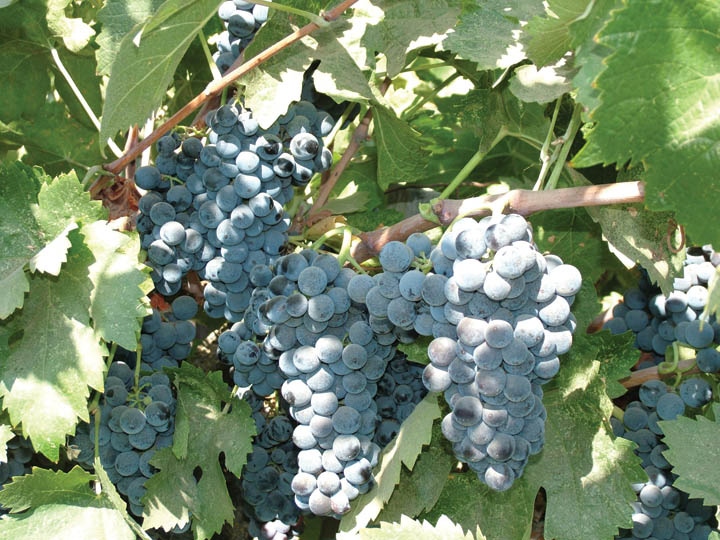
Webspinning spider mites, the most damaging spider mite, can cause significant cellular damage to grape vines. It poses a threat at much lower densities than other mites. Although found on vines in early-mid season, it doesn’t cause damage until mid-season through harvest.
The Pacific spider mite, Tetranychus pacificus is the primary pest mite species in the San Joaquin Valley and may also be the primary pest mite in certain North Coast grape-growing areas. Adult Pacific spider mite females vary from slightly amber to greenish in color. Later in the season as they go into diapause or under high population densities adult females can turn orange to reddish.
When they emerge adult Pacific spider mites have few, if any, food spots. However, one they start feeding, two large diffuse spots usually appear forward and two smaller spots appear on the rear portion of the abdomen. Pacific spider mite prefers the warmer upper canopy of the vine. Although it can cause damage early in the season, Pacific spider mite generally prefers the hotter, dryer part of the season.
Because they are so similar in appearance, it is difficult to discern between the Pacific and Willamette spider mite, Eotetranychus willamettei, unless they are side-by-side. The Pacific mite is larger in size than the Willamette mite. Pacific spider mite forelegs are reddish in color and those of Willamette spider mite are translucent to pale yellow.
The pale yellow Willamette spider mite is often considered an early-season mite. It prefers the cooler parts of the plant and is found mostly in the shady parts of the vine. In certain areas, like The North Coast, and during certain years, populations can persist throughout the growing season. Willamette spider mite is primarily a problem in the Salinas Valley and Sierra foothill production areas where it can cause economic damage to varieties such as Zinfandel.
In the North Coast it can cause damage in early spring when shoot growth is delayed or later in the season in vines with small canopies. Willamette spider mite is seldom a pest in the San Joaquin Valley, especially on Thompson Seedless.
The twospotted spider mite, Tetranychus urticae, is almost identical in appearance to the Pacific spider mite except it rarely has spots on the rear of the body. It is only occasionally found on grapes in California and rarely causes damage.
University of California Cooperative Extension farm advisors offer the following tips and techniques for identifying and managing this costly pest.
They recommend checking for webspinning spider mites and predatory mites weekly during rapid shoot growth on the first emerging leaves. Beginning at bloom divide the vineyard into quadrants. In each quadrant, randomly select five vines each at least a few vines in from the end of the row. Look for mites and mite predators weekly on each of the 20 vines using a 10-14X lens.
Control methods
Early in the season, choose one leaf between the 2nd and 4th nodes on each of these vines. Later in the season, choose the 4th expanded leaf from the growing tip.
A form for recording your findings is available at www.ipm.ucdavis.edu/PMG/C302/grape-leafhoprmite.pdf. This form also offers treatment guidelines for various combinations of Pacific mite injury levels and] predator-prey distribution ratios in Thompson Seedless vineyards.
Damage caused by each species can help in identifying each species. Pacific spider mite damage begins as yellow spots. As damage progresses, dead (necrotic) areas appear on the leaves. High populations can cause leaf burning and bronzing and large amounts of webbing. Damage is worse along the shoulder and tops of the vine canopies.
Willamette spider mite feeding in mid- or late season causes foliage to turn yellowish bronze. Usually, though, no burn occurs unless vines are weak. In red varieties, infested leaves may turn reddish.
Proper management of webspinning spider mites in a vineyard integrates biological, cultural and chemical controls.
Many natural enemies, such as thrips and predatory mites, help control pest mite populations. The western predatory mite, Galendromus (=Metaseiulus) occidentalis, is commonly present in vineyards and can be quite effective in reducing all stages of spider mite populations. This mite is translucent to light amber, pear shaped, and quite active. The effectiveness of this predator depends upon its ability to increase its population size as the season progresses. Disruptive sprays applied early will reduce the survival of this beneficial mite.
Naturally occurring predator mites will survive sulfur sprays and dusts, but released ones may not survive dusting sulfur unless they have sulfur resistance. Predator mites, including insecticide-resistant ones, are available commercially to augment populations in the field.
Other predators, including sixspotted thrips (Scolothrips sexmaculatus), can also be important. To preserve these natural enemies, avoid using disruptive materials, especially carbaryl.
Cultural control measures include applying water or other materials formulated to reduce dust on roads in the vineyard. If possible, maintain resident vegetation or other cover in the vineyard middles to further reduce dust. Irrigate in a manner that will avoid stressing vines. Although overhead watering has been shown to reduce mite problems, it can also increase some disease problems.
Biological and cultural control methods as well as oil or soap sprays are organically accepted methods.
When using chemicals to control spider mites, keep in mind that broad-spectrum insecticides can result in spider mite outbreaks. Consider the ratio of beneficials to pests before spraying. If there is one beneficial for every ten or less mites, hold off spray and continue monitoring.
Do not spray more than twice per season with the same pesticide and alternate types of spray. Follow all labeled instructions for safety, including when it is safe to reenter the vineyard after spraying with no protective clothing.
Note that using some pesticides to control other insects can actually favor mites. Avoid carbaryl (Sevin), organophosphates, and pyrethroids which increase nitrogen in leaves and can cause mite population explosions, especially in hot weather.
More information on pesticide selection and use is available at www.ipm.ucdavis.edu.
About the Author(s)
You May Also Like




